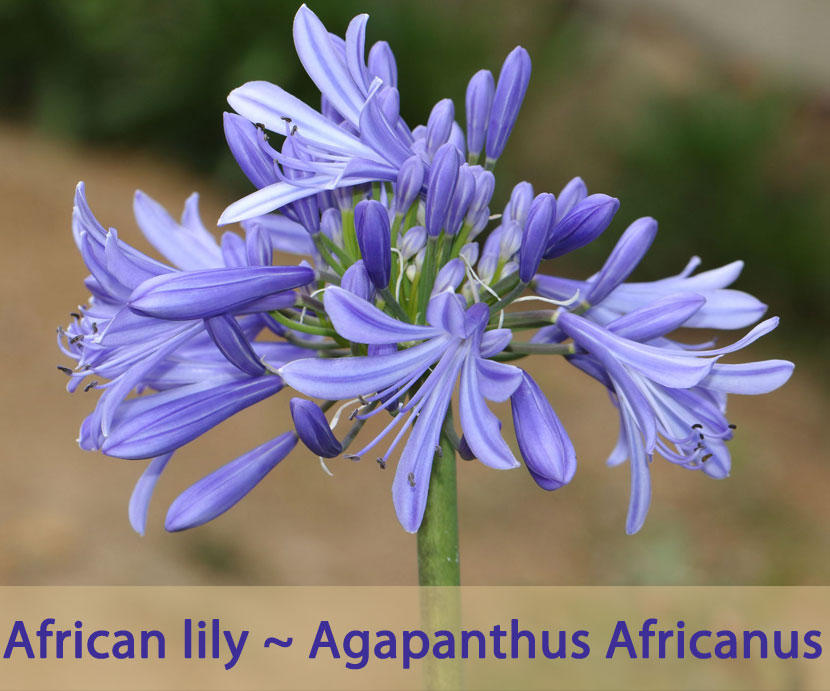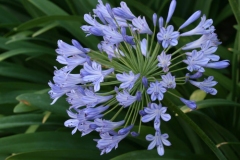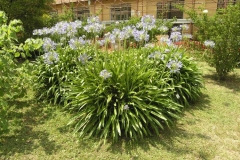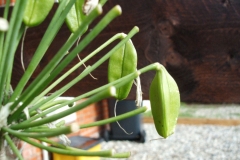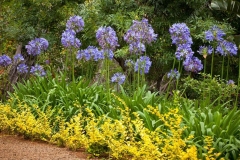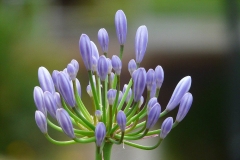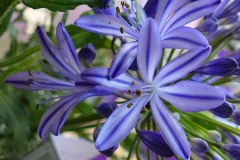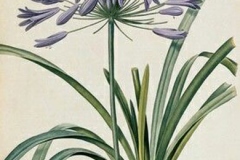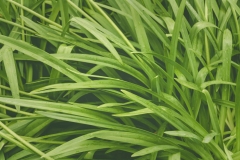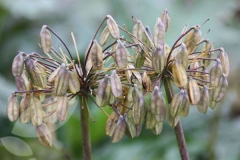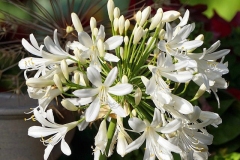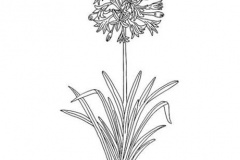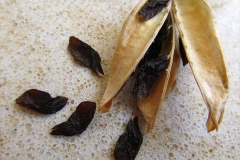The genus name agapanthus (flower of love) is derived from the Greek work agape meaning love, and anthos meaning love. Specific epithet Africanus is derived from Latin word referring to its African origin. African lily is a magical and medicinal plant. The flowers are worn as a protection against thunderstorms. They are also worn by women to provide strength and boost fertility. The plant is known as an aphrodisiac in Africa. The plant has been used for various medicinal purposes. The plant is useful for the treatment of coughs, colds, chest pains, heart diseases and paralysis.
African Lily Facts
| African lily Quick Facts | |
|---|---|
| Name: | African lily |
| Scientific Name: | Agapanthus Africanus |
| Origin | South Africa |
| Colors | Black (Seed) |
| Shapes | Flat and winged (Seed) |
| Health benefits | Support heart disease, paralysis, coughs, colds, chest pains, tightness, fevers, menstrual pains, impotency, barrenness, swollen legs and high blood pressure |
| Name | African lily |
|---|---|
| Scientific Name | Agapanthus Africanus |
| Native | South Africa and from that point, it started propagating to the other parts of the world including Europe, Asia and America |
| Common Names | African-lily, Blue agapanthus, Blue-lily, Lily of the Nile, Cape agapanthus, African agapanthus, African blue lily, blue agapanthus, agapanthe d’Afrique, ail d’Afrique, tubéreuse bleue, love flower |
| Name in Other Languages | Afrikaans: Bloulelie, Kleinbloulelie Belarusian: Ahapantus afrykanski (агапантус афрыканскі) Chinese: Bǎizi lián (百子蓮) Czech: Kalokvět africký Dutch: Afrikaanse lelie, blauwe tuberoos English: African-lily, Blue agapanthus, Blue-lily, Lily of the Nile, Cape agapanthus, African agapanthus, African blue lily, blue agapanthus, agapanthe d’Afrique, ail d’Afrique, tubéreuse bleue, love flower Finnish: Afrikansinisarja French: Ail d’Afrique German: Afrikanische Blaulilie, Afrikanische Schmucklilie Greek: Afrikanikí kríno (Αφρικανική κρίνο) Hindi: Aphreekee lilee (अफ्रीकी लिली) Italian: Agapanto Japanese: Agapansasu (アガパンサス), murasakikunshiran (ムラサキクンシラン) Malayalam: Nailinṟe lilli (നൈലിന്റെ ലില്ലി) Persian: گل نرگس آفریقایی Polish: Agapant afrykański, afrykański Portuguese: Agapanto, lírio africano, tuberosa-azul Russian: agapantus afrikanskiy (агапантус африканский), agapantus zontichnyy (агапантус зонтичный), afrikanskaya liliya (африканская лилия), golubaya afrikanskaya liliya (голубая африканская лилия), krin afrikanskiy (крин африканский) Spanish: Agapanto africano, lirio africano, Agapanto, Flor de amor Swedish: Afrikas blå lilja Telugu: Agāpāntas āphrikānas (అగాపాంతస్ ఆఫ్రికానస్) Upper Sorbian: Afriska pyšnica Zulu: Ubani, uhlakahla |
| Plant Growth Habit | Clump-forming, rhizomatous, semi-evergreen perennial plant |
| Growing Climates | Mountain coastal ranges, rocky places on mountains, between rocks and in depressions on sheets of sandstone rock, subsurface wetlands, in bush land in remnant endangered ecological community. The plants will not tolerate freezing weather for any length of time |
| Soil | Succeed in most soils, but prefers a light, well-drained porous, slightly acidic sandy soil with plenty of leaf-mold |
| Plant Size | 25 to 70 cm (9.8 to 27.6 in) in height |
| Leaf | Leathery leaves are basal, long, sub erect, 2-ranked, and linear-lanceolate, up to 50 centimeters long and 2-4 centimeters wide. Leaves arise directly from the rhizome and may form a leek-like ‘stem’ by sheathing at the base, before separating. Prominent parallel veining is apparent |
| Flowering season | Flowers from November to April. Peak flowering occurs from December to February |
| Flower | Flower stalks are stout, erect, up 30 to 50 centimeters high. Flowers are in umbels, 12- to 30-flowered. Flowers are broadly funnel-shaped, pale to deep blue, and thick-textured with a dark blue stripe running down the center of each petal. The flowers grow in large clusters, with each flower being 25–40 mm (0.98–1.57 in) long |
| Seed | Seeds are black, flat and winged |
| Propagation | By seed or dividing the rhizomes |
| Plant Parts Used | Rhizomes, leaves, root |
Plant Description
African lily is a clump-forming, rhizomatous, semi-evergreen perennial plant that normally grows about 25 to 70 cm (9.8 to 27.6 in) in height. The plant is found growing in mountain coastal ranges, rocky places on mountains, between rocks and in depressions on sheets of sandstone rock, subsurface wetlands, in bush land in remnant endangered ecological community. The plants will not tolerate freezing weather for any length of time. The plant succeeds in most soils, but prefers a light, well-drained porous, slightly acidic sandy soil with plenty of leaf-mold.
Leaves
Leathery leaves are basal, long, sub erect, 2-ranked, and linear-lanceolate, up to 50 centimeters long and 2-4 centimeters wide. Leaves arise directly from the rhizome and may form a leek-like ‘stem’ by sheathing at the base, before separating. Prominent parallel veining is apparent.
| Leaf arrangement | Alternate |
| Leaf type | Simple |
| Leaf margin | Entire |
| Leaf shape | Linear |
| Leaf venation | Parallel |
| Leaf type and persistence | Evergreen |
| Leaf blade length | 8 to 12 inches |
| Leaf color | Green |
| Fall color | No fall color change |
| Fall characteristic | Not showy |
Flower
The slender flower stalk is normally less than 700 mm long, rises from between the leaves and has a pseudo-umbel of pale to dark blue flowers at its apex. There are 20 to 100 flowers in each rounded umbel, depending on variety and species. Flower color ranges from deep violet-blue to pale shades of blue. Rarely, white-flowered individuals are found. At the end of thin pedicels, are open-faced flowers which have prominent darker veins running along the center of the 3 petals and 3 sepals, which fuse at the base to form a funnel-shaped flower. The flower has 6 stamens, the anthers of which produce yellow-brown pollen. The ovary is superior and 3-chambered. Fragrance from the flower is mostly not apparent, although a slight sweet, herbaceous scent may be noticed under some conditions. The plant flowers from November to April. Peak flowering occurs from December to February. Pollination is by bees, wind and sunbirds. They bloom primarily in summer, although in frost-free climates they will bloom over a longer season. The flowers also make good cut flowers, and the dried seed heads can be used in arrangements.
| Flower color | Blue; lavender; purple |
| Flower characteristic | Summer-flowering |
Traditional uses and benefits of African lily
- The roots are cardiac and stomachic.
- They are used in the treatment of heart troubles and intestinal pain.
- It is used by South African traditional healers as phyto-medicine to treat ailments related to pregnancy and to facilitate labor.
- It is used orally or rectally, as a decoction, to ensure an easy delivery and a healthy child.
- It may ease expulsion of the placenta and augment uterine contractions.
- Roots are worn as necklace for easy childbirth and fertility.
- Decoction of the plant is used in washing newborn babies; also, an infant tonic.
- It is considered an aphrodisiac and is used for impotency and barrenness.
- Leaves are used around wrists to bring down fever.
- It may be used for cradle cap or crusts on babies heads.
- It may be used as a medicine for impotency and barrenness.
- The plant has mild purgative, aperient and laxative effects on the gastrointestinal tract and may be applied as a fomentation in severe abdominal pain of a colicky nature.
- It may be used as a body wash to treat paralysis in combination with Dianthus sp.
- It is made into a paste for the treatment of swollen legs.
- Leaves are also said to be soothing for sore and tired feet.
- It is used for chest complaints and as an expectorant in coughs, including long established coughs and for colds.
- It is used for symptoms of heart disease, which includes chest pains and tightness.
- It has been used in the treatment of high blood pressure and has been shown to inhibit angiotensin converting enzyme.
- It is used as a general tonic for infants, a treatment for body rash and to alleviate the menstrual pains of women.
- Leaves may be used to hold dressings in place and wound around wrists are said to bring down fevers.
- An infusion of powdered, sun-dried roots is taken orally for the treatment of cancer.
- The Zulu use agapanthus to treat heart disease, paralysis, coughs, colds, chest pains and tightness.
- It is also used with other plants in various medicines taken during pregnancy to ensure healthy children, or to augment or induce labor.
- Margaret Roberts recommends hikers to put leaves in their shoes to soothe the feet.
Other Facts
- Plant is occasionally gathered from the wild for local medicinal use.
- Young Xhosa brides wear the roots as a necklace as they are said to ensure an abundance of children and easy childbirth.
- The newborn baby may be washed in the decoction to make them strong and keep them free from bowel trouble.
- Isicakathi may be used for a small child who is weak, fails to thrive or gets pimples on the face and bad rashes on the inner thighs or groin area.
- It is used as a protective charm against lightning and thunder and as a medicine taken by people frightened of thunder.
- It is also used as a love charm.
- African lily is a symbol of love.
- It can also symbolize fertility, purity and beauty.
- The flowers are great as cut flowers and will last for up to 10 days in a vase of water.
Precautions
- Leaf may cause pain and ulcerations in the mouth.
- It may be irritating to the eyes and skin.
- It has suspected but unproven hemolytic effects.
References:
https://www.itis.gov/servlet/SingleRpt/SingleRpt?search_topic=TSN&search_value=506476#null
https://pfaf.org/User/Plant.aspx?LatinName=Agapanthus+africanus
http://www.theplantlist.org/tpl1.1/record/kew-293521
https://en.wikipedia.org/wiki/Agapanthus_africanus
https://gd.eppo.int/taxon/AGPAF
http://germoplasma.iniaf.gob.bo/gringlobal/taxonomydetail.aspx?id=1658
http://pza.sanbi.org/agapanthus-africanus
https://www.cabi.org/isc/datasheet/3714
https://tropical.theferns.info/viewtropical.php?id=Agapanthus+africanus
https://plants.ces.ncsu.edu/plants/agapanthus/
http://www.stuartxchange.org/AfricanLily
https://plants.usda.gov/home/plantProfile?symbol=AGAF


